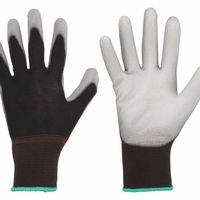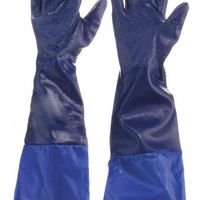Call +(254) 703 030 000 / 751 483 999 / 721 704 777
- Home
- Safety
- Hand Arm Protection
- Safety Gloves
- General Purpose Gloves
.....Read More
Frequently Asked Questions
What are general purpose gloves used for?
General purpose gloves are versatile protective gear designed to safeguard hands in a variety of settings. They are commonly used in industrial, commercial, and domestic environments to provide a barrier against dirt, minor abrasions, and certain chemicals. These gloves are typically made from materials like latex, nitrile, vinyl, or a blend of synthetic materials, each offering different levels of protection and flexibility.
In industrial settings, general purpose gloves are used to handle tools, machinery, and materials, reducing the risk of cuts, blisters, and other minor injuries. They are essential in construction, manufacturing, and assembly lines where workers frequently interact with rough or sharp objects.
In commercial environments, such as food service and janitorial work, these gloves help maintain hygiene and prevent cross-contamination. They protect against exposure to cleaning agents and foodborne pathogens, ensuring both worker safety and product integrity.
In domestic settings, general purpose gloves are used for gardening, cleaning, and maintenance tasks. They protect hands from dirt, thorns, and household chemicals, making chores safer and more comfortable.
Overall, general purpose gloves are an essential component of personal protective equipment (PPE), offering a balance of protection, dexterity, and comfort for a wide range of tasks.
What materials are general purpose gloves made from?
General purpose gloves are typically made from a variety of materials, each offering distinct properties suited for different tasks. Common materials include:
1. **Latex**: Derived from natural rubber, latex gloves are highly elastic, providing a snug fit and excellent tactile sensitivity. They are commonly used in medical and laboratory settings but can cause allergic reactions in some individuals.
2. **Nitrile**: Made from synthetic rubber, nitrile gloves are a popular alternative to latex, offering similar elasticity and puncture resistance without the risk of latex allergies. They are suitable for handling chemicals and are often used in medical, industrial, and food processing applications.
3. **Vinyl**: Composed of polyvinyl chloride (PVC), vinyl gloves are less elastic than latex and nitrile but are cost-effective and suitable for short-term, low-risk tasks. They are often used in food service and light cleaning.
4. **Polyethylene**: These gloves are made from a thin, lightweight plastic and are typically used for food handling and other low-risk tasks. They are inexpensive and designed for single-use.
5. **Neoprene**: A synthetic rubber, neoprene gloves offer good chemical resistance and are used in laboratories and industrial settings. They provide flexibility and protection against a range of substances.
6. **Cotton**: Often used as liners or for light protection, cotton gloves are breathable and comfortable, suitable for handling delicate items or providing a barrier against dirt and minor abrasions.
7. **Leather**: Known for durability and protection, leather gloves are used in construction, welding, and other heavy-duty applications. They offer good grip and resistance to heat and abrasion.
8. **Kevlar**: A high-strength synthetic fiber, Kevlar gloves provide excellent cut and heat resistance, making them ideal for industrial and manufacturing environments.
These materials are selected based on the specific requirements of the task, balancing factors like protection, comfort, cost, and potential allergens.
How do I choose the right general purpose gloves for my needs?
1. **Identify Purpose**: Determine the primary tasks you'll perform. Consider if you need gloves for gardening, construction, cleaning, or general household chores.
2. **Material**: Choose based on durability and protection:
- **Leather**: Offers durability and protection, ideal for heavy-duty tasks.
- **Cotton**: Lightweight and breathable, suitable for light tasks.
- **Rubber/Nitrile**: Provides chemical resistance, good for cleaning or handling liquids.
- **Synthetic**: Combines features of various materials, often used for versatile tasks.
3. **Fit and Comfort**: Ensure a snug fit for dexterity without being too tight. Consider gloves with adjustable closures for a secure fit.
4. **Grip**: Look for textured or coated palms for better grip, especially if handling slippery or small objects.
5. **Protection Level**: Assess the need for cut, puncture, or abrasion resistance based on the tasks.
6. **Flexibility and Dexterity**: Choose gloves that allow for easy movement and handling of tools or objects.
7. **Breathability**: For extended wear, select gloves with breathable materials to prevent sweating.
8. **Size**: Measure your hand to find the correct size. Gloves that are too large can reduce control, while too small can cause discomfort.
9. **Durability**: Consider the frequency of use and choose gloves that can withstand wear and tear.
10. **Cost**: Balance between quality and budget. Higher-priced gloves often offer better protection and longevity.
11. **Brand and Reviews**: Research reputable brands and read customer reviews for insights on performance and durability.
12. **Trial and Error**: Sometimes trying different types is necessary to find the perfect fit for your needs.
Are leather general purpose gloves suitable for construction work?
Leather general purpose gloves can be suitable for certain aspects of construction work, but their appropriateness depends on the specific tasks and hazards involved. Leather gloves offer good abrasion resistance, which is beneficial for handling rough materials like wood, bricks, and metal. They also provide a degree of protection against cuts and punctures, although they are not as effective as specialized cut-resistant gloves for high-risk tasks.
For tasks involving heavy lifting, handling sharp objects, or operating machinery, leather gloves can offer adequate protection and durability. They also provide a good grip, which is essential for safely handling tools and materials. Additionally, leather gloves are generally comfortable and allow for reasonable dexterity, which is important for tasks requiring precision.
However, leather gloves may not be suitable for all construction activities. They are not waterproof, so they are not ideal for wet conditions or tasks involving liquids. They also offer limited protection against chemical exposure, electrical hazards, and extreme temperatures. For these situations, specialized gloves made from materials like rubber, nitrile, or Kevlar may be more appropriate.
In summary, while leather general purpose gloves can be suitable for many construction tasks, it is crucial to assess the specific hazards and requirements of the job. Selecting the right type of glove for each task ensures optimal safety and performance.
What are the benefits of knit general purpose gloves?
Knit general purpose gloves offer several benefits, making them a popular choice for various applications:
1. **Comfort and Fit**: The stretchable nature of knit materials allows these gloves to conform closely to the shape of the hand, providing a snug and comfortable fit. This enhances dexterity and reduces hand fatigue during prolonged use.
2. **Breathability**: Knit gloves are typically made from materials like cotton, polyester, or blends, which allow air circulation. This breathability helps keep hands cool and dry, reducing sweat accumulation and improving comfort.
3. **Versatility**: These gloves are suitable for a wide range of tasks, from light industrial work to general household chores. They can be used in environments where protection from dirt, minor abrasions, and light mechanical risks is needed.
4. **Cost-Effectiveness**: Knit gloves are generally affordable, making them an economical choice for businesses and individuals who require protective handwear in bulk. Their durability also means they can be reused multiple times, further enhancing their cost-effectiveness.
5. **Grip and Dexterity**: Many knit gloves come with coatings on the palm and fingers, such as latex, nitrile, or PVC, which enhance grip and provide additional protection. This feature is particularly beneficial for tasks requiring precision and secure handling of objects.
6. **Easy Maintenance**: These gloves are often machine washable, making them easy to clean and maintain. This feature ensures hygiene and extends the lifespan of the gloves.
7. **Variety**: Available in different thicknesses, materials, and coatings, knit gloves can be tailored to specific needs, offering varying levels of protection and functionality.
Overall, knit general purpose gloves are a practical choice for those seeking a balance of comfort, protection, and affordability.
How do mechanics-style gloves differ from other general purpose gloves?
Mechanics-style gloves differ from general-purpose gloves in several key aspects:
1. **Design and Fit**: Mechanics gloves are designed for a snug fit to provide dexterity and precision, essential for handling small parts and tools. They often feature pre-curved fingers and an ergonomic design to reduce hand fatigue during prolonged use.
2. **Material**: These gloves are typically made from synthetic materials like spandex, neoprene, or synthetic leather, which offer flexibility, breathability, and durability. Reinforced areas, such as the palms and fingertips, provide extra protection against abrasions and wear.
3. **Protection**: Mechanics gloves offer enhanced protection features, such as padded knuckles, impact-resistant materials, and reinforced fingertips, to safeguard against cuts, bruises, and impacts common in mechanical work.
4. **Grip**: The palms of mechanics gloves often have textured surfaces or silicone grips to ensure a secure hold on tools and parts, even in oily or greasy conditions.
5. **Heat and Chemical Resistance**: Some mechanics gloves are designed to withstand moderate heat and resist chemicals, providing additional safety when working with engines or machinery.
6. **Touchscreen Compatibility**: Many modern mechanics gloves include touchscreen-compatible fingertips, allowing users to operate smartphones or tablets without removing the gloves.
7. **Purpose-Specific Features**: Mechanics gloves may include features like hook-and-loop closures for a secure fit, sweat-wicking linings for comfort, and reflective elements for visibility in low-light conditions.
In contrast, general-purpose gloves are often made from cotton, leather, or rubber and are designed for a broad range of tasks. They may lack the specialized features and precise fit of mechanics gloves, making them less suitable for detailed mechanical work.
Can rubber general purpose gloves protect against chemicals?
General-purpose rubber gloves, typically made from materials like latex, nitrile, or vinyl, offer limited protection against chemicals. They are primarily designed for tasks such as cleaning, dishwashing, or handling non-hazardous materials. While they can provide a barrier against mild irritants and some household chemicals, they are not suitable for protection against strong or hazardous chemicals.
Latex gloves offer good elasticity and comfort but have limited chemical resistance, especially against oils, solvents, and strong acids. Nitrile gloves provide better chemical resistance than latex, particularly against oils, greases, and certain solvents, making them a more suitable option for handling a wider range of chemicals. Vinyl gloves are less durable and offer the least chemical resistance, making them suitable only for low-risk tasks.
For effective protection against chemicals, it is crucial to use gloves specifically designed for chemical resistance. These gloves are often made from materials like butyl, neoprene, or Viton, which provide superior protection against a wide range of chemicals, including corrosive substances and solvents.
When selecting gloves for chemical protection, consider the specific chemicals involved, their concentration, and the duration of exposure. Always consult the glove manufacturer's chemical resistance chart to ensure the gloves are appropriate for the intended use. Additionally, inspect gloves for any signs of wear or damage before use, and replace them as needed to maintain safety.
In summary, while general-purpose rubber gloves offer some protection against mild chemicals, they are not suitable for handling hazardous substances. For tasks involving chemicals, it is essential to choose gloves specifically designed for chemical resistance to ensure adequate protection.



